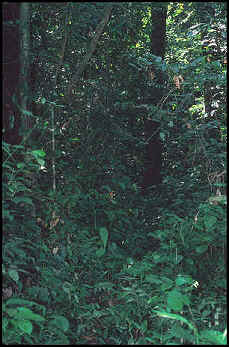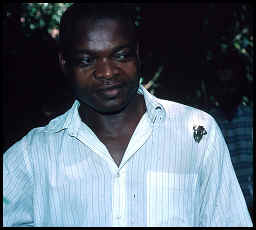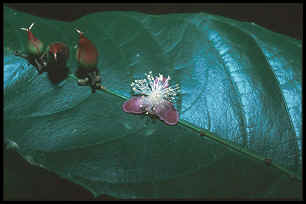Western Cameroon Projects: KORUP NATIONAL PARK
KORUP NATIONAL PARK
Korup National Park is one of the oldest and most biologically diverse areas of lowland rainforest in Africa, rich in animals, plants, and fungi. Designated as a National Park in 1986, Korup lies on the western border of Cameroon's Southwest Province, some 50 km inland from the Bight of Biafra, and comprises an area of some 1260 square kilometres . Average rainfall within the park is over 5000 mm p.a., average temperature 27C, average humidity 86%.
In addition to lowland rainforest, the mid-Korup region includes areas of swamp forest, a small area of secondary forest around the village of Ekundu Kundu, and sub-montane forest associated with Mount Juahan, which is the highest point in the Park. Sub-montane forest is of particularly high conservation value in the Wet Tropics of Africa as it is of limited extent and typically contains a significant number of sub-montane endemic plants.
In 1996, at the invitation of the Korup National Park Project management, RBG Kew in conjunction with Earthwatch Europe and the National Herbarium of Cameroon undertook botanical and mycological inventory work in the mid-Korup region.
|
Phyllobotryum soyaxianum (Flacourtiaceae). Monopodial shrubs remarkable for bearing flowers and fruits along the midribs of the leaves. |
Previous plant and fungus collections had been made in the area, chiefly by Duncan Thomas, who produced a Korup Project Plant List (Thomas, 1993), and Roy Watling of RBG Edinburgh, who published a list of non-agaricoid macrofungi (Hjortstam et al., 1993). In the introduction to the plant list, however, Thomas readily acknowledged it was "by no means complete" and that the field coverage was "very patchy" The same was even more true of the fungi. |
|
Kew projects At the request of the Project management, Kew's inventory work was divided into three elements which were:
Of the twelve 25 x 25 m plots, ten were situated along transects in lowland rainforest at altitudes between 170–550 m, an eleventh plot was situated in freshwater swamp forest (alt 150 m) and the twelfth plot was on Mount Juahan (alt ca. 1100 m).
Understorey of lowland evergreen forest, Korup National Park. 25m x 25m plots in Korup produced the highest in our Cameroon series, over 300 vascular plant species per plot. |
 |
 |
New
discoveries
The preliminary results of the mid-Korup vascular plant inventory work were reported at a workshop on the Korup National Park and Project Area (Cheek & Cable, 1998). In total, approximately 832 fertile plant collections were made with a further 3150 (mostly) sterile plot collections. A new genus, Korupodendron, and several new plant species were discovered amongst the plant collections and a manual of the legumes of mid-Korup was subsequently published by Kew (Mackinder, 1998). Three initial papers on the fungi (Roberts 1999; 2000; 2001) have described one genus and sixteen species new to science. David Oken, staff biologist at Korup National Park. |
References
Cheek, M. & Cable, S. (1998). Preliminary results of the botanical inventory of the Ekundu Kundu region of the Korup Park. In Songwe, N. C. (Ed.), Proceedings of Workshop on Korup National Park & Project Area. pp. 72 - 80. Mundemba, Cameroon: Korup Project.
Mackinder, B. (1998). Manual of the legumes of mid-Korup. 35 pp. Kew: Royal Botanic Gardens.
Hjortstam, K., Ryvarden, L., & Watling, R. (1993). Preliminary checklist of non-agaricoid macromycetes in the Korup National Park, Cameroon and surrounding area. Edinb. J. Bot. 50: 105 - 119.
Roberts, P. (1999). Clavarioid fungi from Korup National Park, Cameroon. Kew Bulletin 54: 517 - 539
Roberts, P. (2000). Corticioid fungi from Korup National Park, Cameroon. Kew Bulletin 55: 803 - 842
Roberts, P. (2001). Heterobasidiomycetes from Korup National Park, Cameroon. Kew Bulletin 56: 163 – 187.
Thomas, D. (1993). Korup Project plant list (all species). 47 pp.


